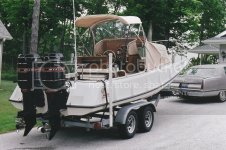DropTop5.0
Well-known member
I am posting this for someone I know that had some problems with one of his inlines. He's running Twin Inlines on a Boston Whaler Outrage 21.

Incidentally, on one of mine (1984 -115), I had a cracked (original) flywheel, and a local dealer in FL who seems to know a lot about these engines, replaced it for me, but could not find the army green colored one (NLA) that the engine uses. So he put on an earlier used red one he had, as used on the distributor models. I questioned it, but he said it would be OK. Well, it wasn't!
After less than a week of use in the saltwater, I was getting tremendous lower unit galvanic corrosion like I have never seen before, and the SS props developed a zinc anode coating in three days. Really strange. So just recently I found a used correct year flywheel on Ebay, and will get that installed when I return to FL. Another Merc mechanic I know thought the red flyweel was generating excess amperage that the engine's electronics couldn't handle and it was escaping into the water via the lower unit. The recitfier on both engines had to be replaced after I brought it in to find out what was wrong. I am now going to have to have the lower unit repaired and repainted. The paint and aluminum was literally being "picked" right off the edges and smooth surfaces. None of this ever happened until the red flywheel went on. So my question to you is have you ever heard of anything like this, or do you know the differences in the earlier and late model (distributorless ignition) flywheels? I would appreciate any knowledge you may have on this subject.

Incidentally, on one of mine (1984 -115), I had a cracked (original) flywheel, and a local dealer in FL who seems to know a lot about these engines, replaced it for me, but could not find the army green colored one (NLA) that the engine uses. So he put on an earlier used red one he had, as used on the distributor models. I questioned it, but he said it would be OK. Well, it wasn't!
After less than a week of use in the saltwater, I was getting tremendous lower unit galvanic corrosion like I have never seen before, and the SS props developed a zinc anode coating in three days. Really strange. So just recently I found a used correct year flywheel on Ebay, and will get that installed when I return to FL. Another Merc mechanic I know thought the red flyweel was generating excess amperage that the engine's electronics couldn't handle and it was escaping into the water via the lower unit. The recitfier on both engines had to be replaced after I brought it in to find out what was wrong. I am now going to have to have the lower unit repaired and repainted. The paint and aluminum was literally being "picked" right off the edges and smooth surfaces. None of this ever happened until the red flywheel went on. So my question to you is have you ever heard of anything like this, or do you know the differences in the earlier and late model (distributorless ignition) flywheels? I would appreciate any knowledge you may have on this subject.





 l115
l115